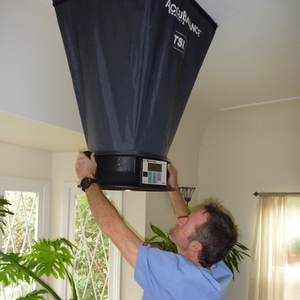
Image Credit: Image #1: Martin Holladay
What’s a “faith-based ventilation system”? It’s a ventilation system installed by a contractor who never verifies the air flow rates after the equipment is installed.
So, will this type of ventilation system work? It’s hard to say — because no one measured anything.
At last month’s BuildingEnergy 16 conference in Boston, two ventilation experts — Terry Brennan and David White — gave a presentation titled “Moving Beyond Faith-Based Ventilation.” Brennan and White explained why new homes need mechanical ventilation systems, and shared important design principles underlying these systems. They ended their presentation by providing advice on (and a demonstration of) different ways to measure airflow.
Terry Brennan is a building scientist and a member of the ASHRAE 62.2 committee (the committee responsible for the residential ventilation standard). David White is a principal at Right Environments, a New York architectural firm, and an assistant professor at Parsons.
You’re not getting the airflow you think you’re getting
Most builders have no idea whether the ventilation equipment they install is working properly. Many builders assume, for example, that a bathroom exhaust fan rated at 110 cfm is moving 110 cfm of air. It almost certainly isn’t, as anyone who bothers to measure their fans’ performance soon learns.
A few years ago, GBA blogger Allison Bailes recounted the tale of a builder who installed nine bathroom exhaust fans, each rated at 110 cfm. While the builder assumed that each of these fans would be able to move at least 50 cfm — less than half of their rated airflow — it turned out that only five of the nine of the fans achieved that fairly modest goal. (One fan barely limped over the finish line — it was tested at 51 cfm.)
When tested, four of the nine fans — the ones moving between 30 and 46 cfm — were particularly pathetic.
What about…
Weekly Newsletter
Get building science and energy efficiency advice, plus special offers, in your inbox.

This article is only available to GBA Prime Members
Sign up for a free trial and get instant access to this article as well as GBA’s complete library of premium articles and construction details.
Start Free TrialAlready a member? Log in















12 Comments
Measure air flow and then?
1. I like the idea of testing (though I'm sure I'll get some amount of push back from the contractors). You mention "most ducts have elbows; many ducts are long; some are leaky; many are convoluted; and some have the wrong diameter." - that makes sense. But if we go ahead and do the tests and find that we're not getting the ventilation that we expect - what practical options do we have at that point? Rip out the ducting?
2. Can an HRV exhaust in a bathroom replace the need/requirement for a dedicated bathroom fan? If so - what CFM would be required? Is it ok for the humidity of a shower to be pulled into the HRV?
Response to Adam Wride
Adam,
Q. "If we go ahead and do the tests and find that we're not getting the ventilation that we expect - what practical options do we have at that point?"
A. The options are the same as for any other discovery that reveals a construction error. Basically, you can either (a) ignore the problem, or (b) fix it.
I discussed possible fixes in my 2014 article, Bathroom Exhaust Fans:
"Let’s say that your fan is hooked up to a funky duct system, and it’s only pulling 35 cfm. There are two solutions to this problem: you can swap out the 110 cfm fan for a more powerful model — say, a 200 cfm fan — or you can fix all the duct problems. (A good duct system has a large diameter, smooth walls, and few elbows.) Either approach will work, but the latter approach is preferable — because the system will use less energy and will be quieter.
"Fan makers have begun to respond to reports that builders are failing the 50 cfm airflow test by offering more powerful fans. For example, ads for Panasonic’s EcoVent fan boast that the fan includes a booster switch that a builder can flip to ramp up the fan’s speed if the fan fails its airflow test. While that solution is easy for the builder, a better solution would be to fix the funky ductwork."
It seems a more sure and less hassle way to ensure flow is simply to be sure of and DO the following in this order:
1) specify and order a bath fan rated at X CFM @ Y "water gauge, eg. 50 CFM @ 0.2"wg
2) specify and install ONLY smooth galv. and PVC duct / tubing and at lengths which are sure to be less than 0.2"wg equivalent length resistance. There are simple tables available for both straight lengths and elbows. You add up the resistance for feet of 4" or 6" tube to the resistance for # of elbows and it should be less than 0.2"wg. Pretty simple. Now enforce the HVAC sub's workers DO that; have it IN THE CONTRACT: if your inspection reveals MORE resistance than spec it will be at sub's cost to install per spec.
3) no testing. You can simply believe the spec of any major manufacturer. Nothing wrong with that!
Really the same thing should go many other systems too. For example, should you have your plumber prove to you that his pump is pumping at 2.4 gpm with 4 psi back pressure? How will you set THAT testing up? Is it practical?!
Brian,
I'm not sure which method is easier: adding up all the fittings and the lengths of the duct to figure out whether the static pressure will exceed 0.2"wg, and then verifying that the contractor installed exactly the fittings that I expected the contractor to use -- or just testing the airflow with an Exhaust Fan Flow Meter from The Energy Conservatory.
I think most builders would say, "It's easier to just test."
Yeah, likely quite debatable . . . however, if it fails the flow test you have some considerable inability to judge the reality of the test and what exactly the decision is to be made:
For example:
-- What is the accuracy of the tester? + or - 5 cfm? SO, if the 50 cfm fan tests out at 42 cfm it could be as low as 37 cfm or 47 cfm; Do you tell your sub he pulls the fan and duct if it is even one cfm low or would you say, OK, 47 is close enough. The point: no controversy, decision to make if you just look up in the attic and count Els, see it is smooth pipe(mostly) and estimate length. That takes maybe 4 minutes per fan?
-- Will the sub point the finger back at you? He could easily say well you bought too small fan, it's not my fault! However, if he fails to use YOUR spec pipe(too much flex) and 20 Els there is not much to argue about. Pull it.
-- The cost to test: You have to buy the air flow tester, store it, have a guy that can reliably use it and trust he will use it and not just pass the sub because they have done 5 jobs working with each other. You have to pay him. What? $20/ test x 3 or 4 fans /house? OR you could pay him (or just look yourself) up into that attic to inspect your sub's work. After all, don't you inspect the plumber's work after he lays the radiant tubing before concrete is poured. I do not see any difference. Contracting is following specs and drawings.
Second response to Adam Wride
Adam,
Q. "Can an HRV exhaust in a bathroom replace the need/requirement for a dedicated bathroom fan? If so - what CFM would be required? Is it ok for the humidity of a shower to be pulled into the HRV?"
A. Answers to your questions can be found in my article, Does a Home with an HRV Also Need Bath Fans?
Martin - thanks!
Thank you for pointing those out. I've found the index you built and now realize there is an article for just about everything here. Pretty incredible.
Thanks, Adam
Adam,
I'm glad that you like the index.
If any GBA readers are wondering what Adam is talking about, it's this page: How To Do Everything.
Are range hoods improving?
Following the links in this article, and some links from those links, it looks like there was no satisfactory solution to cooking-produced pollution, when some of the articles were published, four years ago. The most effective range hood discussed was described as being too loud to hold normal conversation in the kitchen. Jumping forward to this current GBA article, "Brennan advised, remember that 'a fan shouldn’t be louder than a refrigerator.'" Does the market now offer any range hood product, that can come close to meeting Brennan's advice on fan loudness, while providing reasonable effectiveness in removing the pollutants from cooking?
Response to Derek Roff
Derek,
I have forwarded your question to Terry Brennan. I also invite other GBA readers to respond.
Rooftop Exhaust Fan Measurement
This Building America report shows the method of using a "flow box" for measuring rooftop exhaust fan flows ("BA-1209: Multifamily Ventilation Retrofit Strategies," http://buildingscience.com/documents/bareports/ba-1209-multifamily-ventilation-retrofit-strategies/view). The downside of the "flow box" is that you have basically built a lightweight box kite that's sitting on top of a multistory building roof. Losing your equipment off the roof due to wind gusts has the potential to be really embarrassing!
But more interestingly: this CEE report ("Multifamily Ventilation Assessment and Retrofit Guide," http://mn.gov/commerce-stat/pdfs/card-report-mf-family-vent-retrofit.pdf) does a great job of summarizing several methods for measuring rooftop exhaust fan airflows, including inserting an Energy Conservatory TrueFlow into the "throat" of the rooftop exhaust. Lots of clever stuff from Jim Fitzgerald and colleagues.
Response to Kohta Ueno
Kohta,
Thanks for providing the links to two excellent online resources for those who need to measure ventilation system air flows in a multifamily building.
I've taken the liberty of posting a photo from the second resource you linked to (Multifamily Ventilation Assessment and Retrofit Guide). Jim Fitzgerald knows a lot about ventilation.
.
Log in or become a member to post a comment.
Sign up Log in